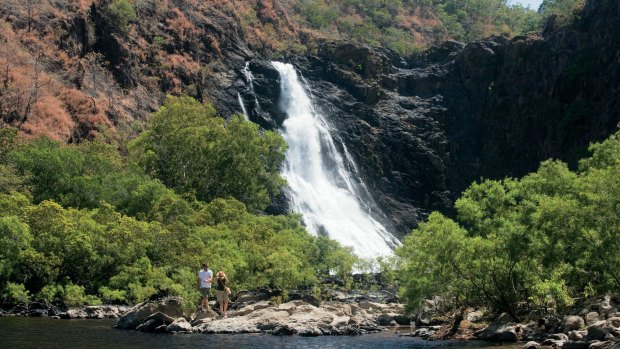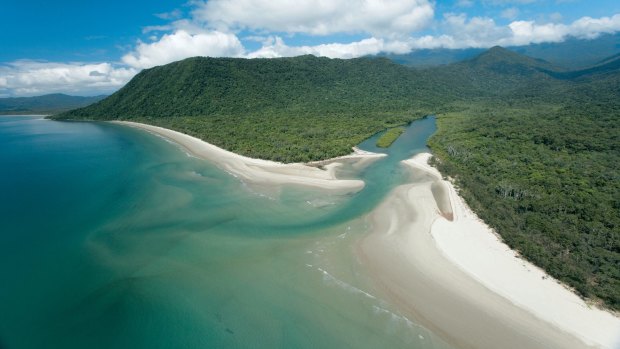This was published 4 years ago
Far North Queensland road trip: Travel tips on driving Cape Tribulation and The Bloomfield Track to Cooktown
By Steve Meacham

The Wujal Wujal Falls, aka the Bloomfield Falls, are most spectacular in the wet season.Credit: Darren Jew
When tourists arrive at a particularly idyllic Queensland beach after strolling through two kilometres of pristine rainforest, they're greeted by two signs. One warns that salt-water crocodiles inhabit the sands and mangroves as well as the sea. The other explains that vinegar (who carries that to the beach?) is the best salve for the excruciating pain when your skin comes in contact with Chironex fleckeri (aka box jellyfish or "stinger"). Welcome to Cape Tribulation.
As most Australians know, this promontory was named by Captain James Cook after the Endeavour ran aground on the Great Barrier Reef in 1770. "Here began all my troubles," Cook wrote, explaining why he gave a superb landscape such a gloomy name. Today, "Cape Trib" is as far as most tourists get. It's a three-hour drive north of Cairns (via Port Douglas), the World Heritage-listed (and endangered) Daintree rainforest and a ferry crossing over the Daintree.
Most visitors take their time getting here, calling in at Mossman Gorge, and spending the night at Cape Trib. Obviously swimming is out, but there's plenty to do. You can hire a kayak, take a half-day tour to the reef, speed down a flying fox, ride horseback, enjoy two interpretative bush walks or just admire the view from the lookouts.

Cape Tribulation's pristine beaches are alluring but also the haunts of salt-water crocodiles.Credit: Darren Jew
But this morning I'm pressing further north, following the mighty Bloomfield Track to Cooktown. Once Cape Trib itself was inaccessible unless you were travelling by boat. The first motorist to reach Cape Trib was Marion Swenson, driving a converted army Bren Gun Carrier and crossing creeks and beaches at low tide. Fortunately, since 1962 there's been a sealed road north of the Daintree ferry. After Cape Trib, however, you need a 4WD.
You can drive between Cairns and Cooktown on bitumen via the inland route (330 kilometres, mainly on state highway 81), but I'd reserve that for a relaxing return trip. For an adrenalin rush, the Bloomfield Track's the go. It would be inexcusable, however, not to mention that the 30-kilometre dirt track, which crosses the Bloomfield River, was the source of blockades in the early 1980s during Joh Bjelke-Petersen's premiership. The ultimate result was an environmental victory with the Daintree declared a World Heritage site.
The track was designed with minimal switchbacks, resulting in steep inclines. In Cairns, the only four-wheel-drive I could hire was a battered manual ute permanently tuned to a country music station. I felt a little cheated as I left Cape Trib on the dirt track and was quickly overtaken by a two-wheel-drive backpacker passion wagon emblazoned with double-entendres. A few kilometres later, they pulled over into the mangroves for what I presumed was a quick swim. Ten minutes onwards, I reached Emmagen Creek: where all 2WD vehicles have to stop.
It was the driest spell the Daintree had experienced in decades yet, as I selected the lowest 4WD gear, I wondered whether I'd ticked the right insurance option. The waters rose, the river stones bounced the cab and the radio blared out Troy Cassar-Daley. Reaching the other side without stalling, I felt I had crossed the Styx. Every other creek I negotiated after that was dry. But please check beforehand: 4WD diehards don't even consider going until the creeks are up and the track is wet, but they have winches, tents and back-up.
Though the Bloomfield is also called "the coastal route", you don't often see the ocean. And if you're driving, your attention will be on what passes as the road. You'll eventually conquer Donovan's Ridge, then Mount Sorrow Ridge before the track ends with the bridge over the Bloomfield.
Take time to visit the Bana Yirriji Art and Cultural Centre which displays works by local Indigenous artists at affordable prices. This country will forever be associated with the Wujal Wujal people (roughly translated as "many falls") and what used to be known as Bloomfield Falls has been renamed after them (the best time to visit is after the wet season). From now on you're back on the bitumen.
Getting thirsty? Hold out for the timber-built Lion's Den Hotel on Shipton Flat Road. Few pubs fulfil the Crocodile Dundee image more than this Aussie classic. Founded as a drinking hole for miners in 1875, its walls are covered in signatures, its side room contains a small museum, its beer garden is bombed by falling mangoes from 100-year-old trees and its ale is more than refreshing. If only there weren't another 30 kilometres to reach Cooktown.
TRIP NOTES
Steve Meacham travelled at his own expense.
MORE
Sign up for the Traveller Deals newsletter
Get exclusive travel deals delivered straight to your inbox. Sign up now.